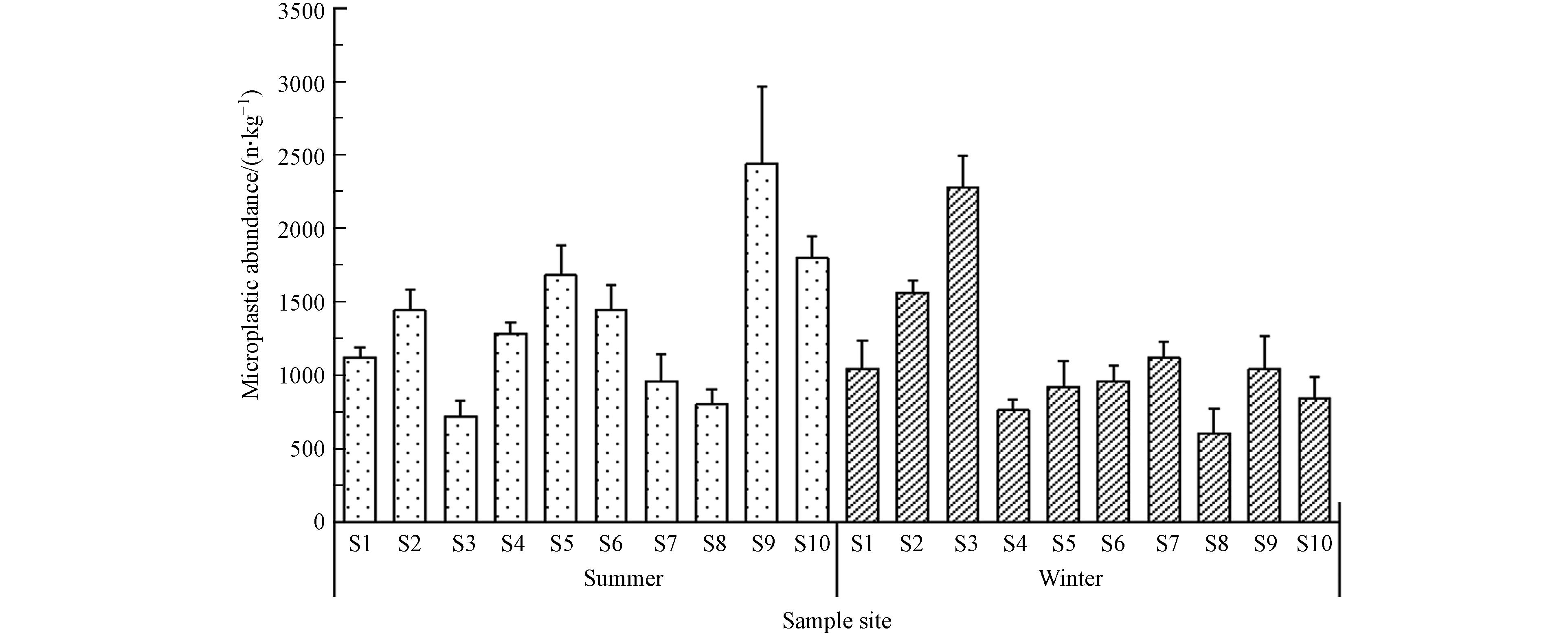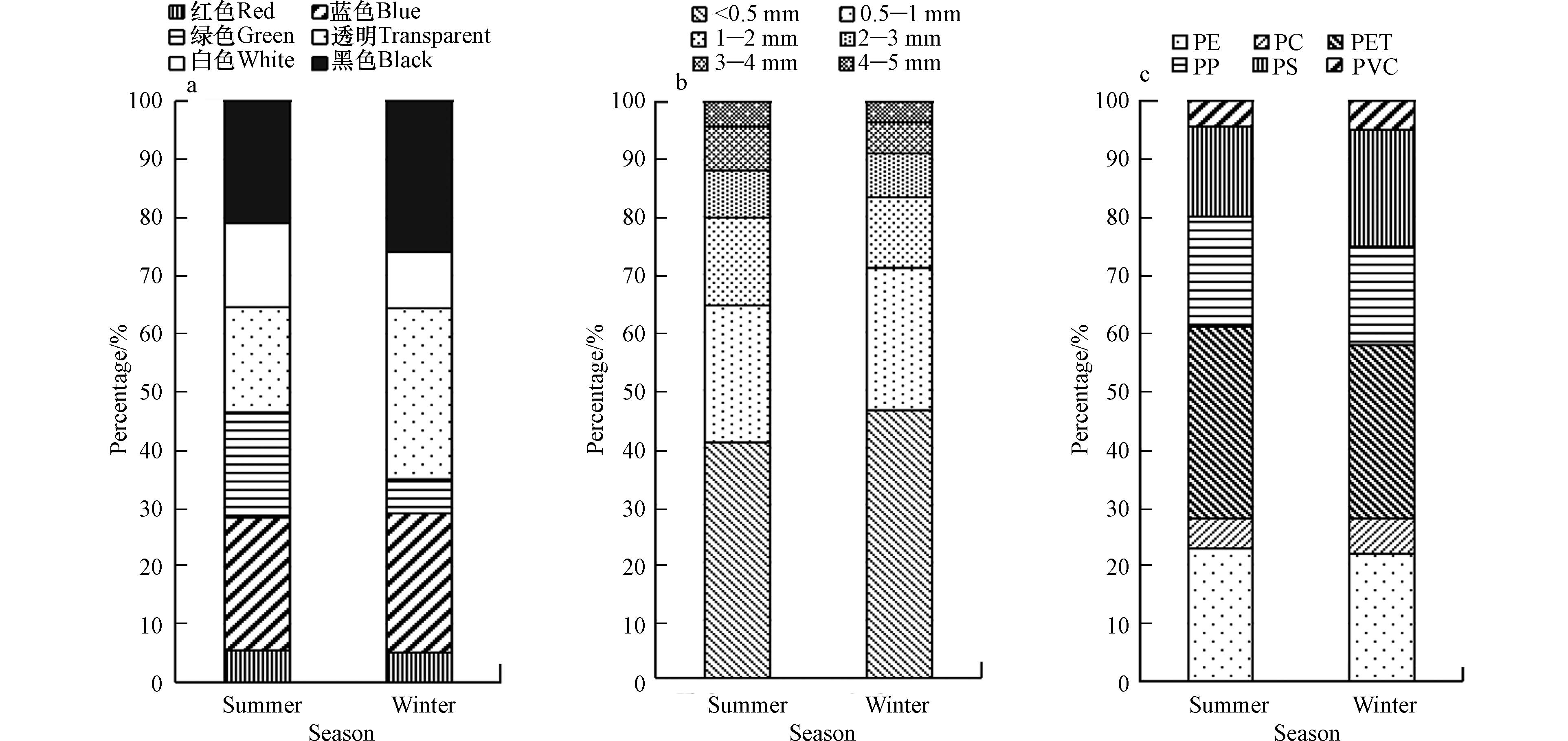-
近年来,塑料制品生产及使用量急剧增加,加之塑料垃圾处理不当和回收率低的原因,导致塑料在自然环境中大量积累[1]. 据报道至2050年,全球每年塑料产量可能达到330亿吨[2]. 数量巨大的塑料制品在光照、海浪冲击、侵蚀、风化等外界作用下会逐渐分解为直径小于5 mm的小塑料颗粒,即微塑料. 微塑料在环境中具有持久性且不易降解的特点[3],其长时间暴露在环境中[4]易造成潜在的环境风险[5-6]. 作为一种新型污染物,微塑料所引发的生态安全已成为全球关注的热点环境问题之一[7].
目前,微塑料已在水生态系统中被广泛检出[8]. 如中国南海、渤海、东海等海域[9-10],黄河、长江等河流[11-12],鄱阳湖、南湖等湖泊均发现不同程度的微塑料污染[13-14]. 已有研究表明,沉积物是淡水生态系统微塑料的“汇”[15]. 沉积物中微塑料的累积、迁移和分布受气象条件、水流和水生生物等在内的多种因素的影响[16-18]. 此外,微塑料的数量也与人口和人类活动(如船舶、港口作业、捕鱼、塑料生产和污水处理)密切相关[19-20]. 可见,沉积物微塑料的分布与所在水域自然及人为因素的影响密不可分,针对特定水域开展湖泊沉积物中微塑料分布特征的调查,将对该水域微塑料污染背景数据的积累具有重要意义.
本研究以金山湖沉积物为研究对象,研究金山湖沉积物微塑料的丰度、分布特征和季节变化规律,评估微塑料在金山湖沉积物中的污染情况,研究结果将为半封闭式闸坝型城市湖泊沉积物中微塑料的污染状况提供基础数据.
-
研究区域位于江苏省镇江市金山湖,该区域属于亚热带湿润气候,平均气温14.8—15.3 ℃,平均年降水量为1044.6 mm[21].
金山湖(32°13'4.652"—32°14'35.79"N ,119°25'5.711"—119°29'48.049"E)位于江苏省镇江市内,金山湖东西方向长约4 km,南北宽约2 km,湖泊丰水期面积为8.8 km2,在镇江城市地表水中所占面积约80%以上[22],是镇江市最大的景观湖泊和重要的防洪水体,且是镇江市金山、焦山、北固山“三山”名胜景区的核心所在[23]. 该湖泊为闸坝型水体,1987年来开通了连接金山湖与长江的引航道[24],引航道闸坝从长江引水进入金山湖,并穿过下游胶南坝使水回流至长江,从而实现金山湖水位的调控[25].
-
在综合考虑镇江市金山湖水体分布特征、水域面积及人类活动的程度等基础上,在金山湖共选取10个点位进行样品采集,具体点位见图1所示.
采用彼德森抓泥斗抓取沉积物,在2019年1月(冬季)和7月(夏季)在选取的10个点位采集表层沉积物样品,每个点位采集3个平行样,将同一采点位样品充分混匀,带回实验室. 将样品在45 ℃的烘箱中烘干、砸碎、过5 mm筛,并用铝箔包好,保存在干燥处储存,用于微塑料的样品前处理.
-
采用密度分离法提取沉积物中微塑料[26]. 首先将50 g沉积物样品(干重)转移到一个干净的锥形瓶中,加入500 mL饱和氯化钠溶液,用干净的玻璃棒搅拌2 min,直到沉积物和溶液完全混匀. 瓶子用铝箔密封,以防止样品污染,并静置24 h,等待固体和液体分离完全,确保微塑料完全悬浮在上清液中. 随后,将上清液转移到另一个干净的锥形瓶中,并在剩余的沉积物中加入饱和碘化钠溶液,进行二次浮选. 重复上述相同的步骤来分离固体和液体. 为避免有机质的干扰,在提取的上清液总加入30%的过氧化氢溶液,然后用铝箔将瓶子密封,在45 ℃的水浴中加热48 h. 待有机质消解后,使用Φ50 mm×0.45 μm醋酸纤维素膜对上清液进行真空过滤,将滤膜置于培养皿中保存,以备后续对微塑料的观测.
-
采用金相显微镜(CX40M, Ningbo Sunny, China)在放大50—100倍下通过软件IMSA-2000对干燥滤膜上的微塑料进行拍照计数. 研究表明[27],微塑料按形态特征分为即纤维、颗粒、碎片、薄膜状微塑料共4种类型. 按颜色分为红色、蓝色、绿色、透明、白色和黑色共6类[28]. 根据其粒径不同可分为<0.5、0.5—1、1—2、2—3、3—4、4—5 mm等类型[28-29].
选择具有代表性的微塑料样品,采用拉曼光谱仪(DXR, Thermo Fisher, USA),根据已知的聚合物光谱确定微塑料的聚合物类型,对微塑料样品的化学组成进行识别[30]. 由于样本量较大,采用所有颜色及形状的微塑料组合,以确保所有类型都被检测到,并且根据显微镜的观察进行微塑料聚合物类型的统计分析.
本研究中,利用扫描电子显微镜结合能量光谱仪(SEM/EDS),研究了微塑料样品的表面性质. 即:用拉曼分析对微塑料进行鉴定后,将样品涂上铂薄膜,用20 kV扫描电镜(S-3400N,Hitachi, Japan)与可变真空钨丝观察. 由于微塑料表面的侵蚀程度不同,在不同的表面位置和粗糙度下至少进行了3次可视化分析.
-
使用软件 WPS Office 进行数据的处理和表格的绘制. 本研究采用双因素方差分析来确定在P<为0.05时,微塑料的季节变化和空间变化是否具有统计学意义. 采用SPSS v. 27(IBM公司,Armonk,NY,USA)进行空间与季节的双因素方差分析. 微塑料丰度数值采用平均值表示,丰度采用每kg干重沉积物的颗粒数表示,单位为n·kg−1 .
-
由图2可知,金山湖所有点位表层沉积物均检测到了微塑料,夏季沉积物中微塑料丰度范围为720—2440 n·kg−1干重沉积物,平均丰度为1368 n·kg−1,冬季则为600 — 2280 n·kg−1,平均丰度为1112 n·kg−1干重沉积物. 对比其他湖泊沉积物微塑料丰度值后发现,金山湖微塑料丰度低于牛轭湖沉积物(347—4031 n·kg−1和507—7593 n·kg−1)[31],高于太湖沉积物微塑料丰度(11.0—234.6 n·kg−1)[32]、雨山湖(278.9、277.1 n·kg−1)[33]和洞庭湖(180—693 n·kg−1)[34]. 金山湖沉积物微塑料丰度平均值与鄱阳湖相近(921.6 n·kg−1和996.2 n·kg−1)[15]. 总体而言,本研究所测金山湖沉积物微塑料丰度值在中国已观测的沉积物微塑料丰度范围之内.
金山湖沉积物微塑料丰度值冬季两季变化明显. 冬夏两季10个采样点沉积物微塑料丰度值的方差分析结果表明,S3、S4、S5、S6、S9和S10点位在两个季节丰度值存在显著差异(P<0.05). 其中,S2、S3和S7采样点沉积物微塑料丰度平均值表现为冬季>夏季,其余点位则表现为夏季>冬季,由此可判断,金山湖70%沉积物在夏季微塑料丰度略高于冬季,这与夏季降雨量较大等有一定的关系. 研究表明,降雨充沛时微塑料可从陆地转移到湖泊沉积物,从而使湖泊沉积物中微塑料丰度升高[35].
除了季节差异,沉积物中微塑料丰度在空间分布上亦表现出显著的差异(P<0.01). 已有研究表明,河流和湖泊等环境中微塑料丰度与人类活动等因素密切相关[36-37]. 人类活动较为频繁的地区往往会造成严重的塑料堆积和污染[19]. 如研究发现人流量增加引起微塑料的丰度显著升高[38-39]. 而城市较高的人口密度引起的塑料制品消费增加也会产生更多的微塑料污染[40]. 金山湖位于镇江市中心,作为镇江市的著名风景区吸引大量游客,尤其是夏季,大量的游客在金山湖水域开展各项活动,增加了塑料制品的污染风险. 其次,城市建筑材料、汽车轮胎等频繁使用,将导致微塑料随大气干、湿沉降以及随地表径流等从陆地进入湖泊生态系统[41].
-
金山湖表层沉积物微塑料从形态上主要分为4类:纤维状、颗粒状、碎片状和薄膜状(图3). 夏季沉积物微塑料中,纤维状微塑料占比57.3%,其次是碎片状(26.3%)、颗粒状(11.1%)和薄膜状(5.3%);冬季沉积物微塑料中,纤维状微塑料占比70.5%,其次是碎片状(16.2%)、颗粒状(7.9%)和薄膜状(5.4%). 冬夏两季微塑料形状占比均表现为:纤维状>碎片状>颗粒状>薄膜状,表明冬夏两个季节金山湖沉积物中微塑料形态组成均以纤维状为主,这与Malla-Pradhan等[42]在费瓦湖沉积物的研究结果类似. 已有研究表明,纤维状微塑料具有大的比表面积,因此生物膜易附着在其表面,可降低纤维状微塑料的浮力[43],促使其沉降. 此外,纤维状微塑料还可能与渔业和生活污水排放有关. 研究表明[44],洗衣机出水中纤维状微塑料丰度可达100 n·L−1;其次,老化的渔网渔具也会形成纤维状的微塑料[45]. 除了纤维状微塑料,其他形态如碎片状和薄膜状等主要是塑料制品自然分解所产生,如塑料包装袋、农用地膜和塑料容器[46]. 颗粒状微塑料主要来源于个人护理及化妆品等,如调查发现面部擦洗产品中微塑料平均含量约为20.86 n·mg−1[47].
-
金山湖沉积物中共检出6种颜色微塑料,其中红色、蓝色、绿色归类为彩色微塑料. 如图4(a)夏季沉积物微塑料颜色占比分别为蓝色(22.81%)>黑色(21.05%)>绿色(18.13%)=透明(18.13%)>白色(14.33%)>红色(5.56%);冬季沉积物微塑料颜色则表现为透明(29.50%)>黑色(25.90%)>蓝色(24.10%)>白色(9.71%)>绿色(5.76%)>红色(5.04%). 夏季蓝色微塑料占优势,而冬季透明微塑料占比最高,此外,夏季彩色微塑料显著高于冬季的彩色微塑料,如绿色微塑料可能来源于渔网、渔具等. 此外,目前市场上彩色塑料制品占比较高也是沉积物彩色微塑料丰度较高的重要原因之一[48]. 黑色微塑料可能是农用地膜和轮胎使用所产生. 已有研究表明,在光照的作用下环境中微塑料易发生风化,含氧官能团的增加导致微塑料发生褪色[49]. 基于多种因素,金山湖沉积物微塑料颜色呈现出多样性的特征. 而彩色微塑料与营养水平较低的生物体类似,更易被生物摄食[50],从而增加了生态风险.
微塑料按其粒径可分为<0.5、0.5—1、1—2、2—3、3—4、4—5 mm共6个范围[51]. 如图4(b)所示,金山湖沉积物冬夏两季微塑料丰度均随粒径的增加而减小,这与洞庭湖[52],三峡水库[53]等研究结果一致. <0.5 mm微塑料的丰度最高,冬夏季分别占微塑料总量的46.40%和40.94%,这与其他研究结果类似,如鄱阳湖沉积物中<0.5 mm粒径的微塑料>70%[54],雨山湖和南湖沉积物粒径<0.5 mm的微塑料分别占比46.02%和62.79%的[33].
此外,将<1 mm的微塑料定义为较小尺寸的微塑料[55],按此标准,冬季<1 mm(71.22%)的微塑料占比略高于夏季(64.62%),表明在两个季节中较小尺寸微塑料占主要优势,这可能与金山湖的水位调控,以及长江支流等[56]水体中<1 mm的微塑料占主要优势有关. 研究已证实,小尺寸微塑料占比高的原因可能由于污水处理厂不能对小尺寸微塑料进行很好的去除[57];此外,小尺寸的微塑料可能是大尺寸的塑料经过机械磨损、氧化和生物等作用下发生碎裂和降解所形成[58]. 由于小尺寸微塑料具有较大的比表面积,能对环境中的重金属离子等有害元素进行吸附,往往成为这些有害元素的载体,极易被水生生物摄食并在食物链中循环,从而产生生物毒性效应[59-60],并最终对人类健康造成危害. 由于较小尺寸的微塑料粒径小,沉积物中的较小尺寸微塑料更容易二次悬浮至水中,加剧水体危害[61]. 因此,沉积物中较小尺寸的微塑料在湖泊生态系统中具有更大的潜在生态风险.
-
利用拉曼光谱仪对微塑料成分进行检测后发现,金山湖沉积物微塑料共有6种聚合物类型,分别为聚乙烯(polyethylene PE)、聚碳酸酯(polycarbonate PC)、聚对苯二甲酸乙二醇酯(polyethylene terephthalate PET)、聚丙烯(polypropylene PP)、聚苯乙烯(polystyrene PS)和聚氯乙烯(polyvinyl chloride PVC). 金山湖冬夏两季沉积物微塑料聚合物类型较为相似,冬季沉积物中PET占优势(29.86%),其次为PE(21.94%)、PS(20.14%)、PP(16.91%)、PC(6.12%)和PVC(5.04%),夏季沉积物PET、PE、PP、PS、PC、PVC占比分别为33.04%、22.81%、19.01%、15.50%、5.26%和4.39%,占比最少的为PC和PVC. 以上微塑料都是较为常见的聚合物类型. 其中,PE主要用于农用地膜、网和钓鱼线等;PC主要来源于建筑材料、汽车和其他工业用途,PET是纺织品常见的组成部分,其可以通过洗涤废水进入湖泊中,这可能是湖泊沉积物PET微塑料占比较高的主要原因;PP是服装、医疗等生活必须品的主要原材料;PS和PVC则通常用于包装和工业目的[62]. 由此可推测金山湖沉积物中微塑料污染可能主要来源于洗涤废水、包装和老旧渔具等,在今后的研究中需进一步追溯其源头. 扫描电镜的结果显示金山湖沉积物中的微塑料均呈现表面粗糙、多孔、撕裂和裂缝,表明由于水流及沉积物的运动,微塑料经历了不同程度的侵蚀和风化(图5).
-
(1)金山湖沉积物中微塑料夏冬季平均丰度分别为1368 n·kg−1 和1112 n·kg−1,夏季表面沉积物中微塑料丰度平均值高于冬季.
(2)金山湖沉积物中微塑料的形状包括纤维状、碎片状、颗粒状和薄膜状,其中纤维状微塑料在夏季和冬季沉积物中均占比最高,分别为57.3%和70.5%.
(3)金山湖冬季沉积物中微塑料颜色分别为透明(29.50%)、黑色(25.90%)、蓝色(24.10%)、白色(9.71%)、绿色(5.76%)和红色(5.04%);夏季沉积物微塑料颜色分别为蓝色(22.81%)、黑色(21.05%)、绿色(18.13%)、透明(18.13%)、白色(14.33%)和红色(5.56%).
(4)金山湖冬季和夏季沉积物中微塑料以较小尺寸(<1 mm)微塑料为主,占比分别为71.22%和64.62%.
(5)冬季和夏季金山湖沉积物中微塑料聚合物类型均以PET和PE为主,冬季沉积物中PET和PE分别占总数的29.86%和21.94%;夏季沉积物微塑料PET和PE分别占总数的33.04%和22.81%.
(6)冬夏两季金山湖沉积物中微塑料均存在表面粗糙、多孔、撕裂和裂缝等情况.
金山湖沉积物微塑料形态与分布特征
Morphology and distribution characterization of microplastic in sediments of Jinshan Lake
-
摘要: 微塑料作为一种新型污染物,对自然环境所造成的潜在风险已成为当前广泛关注的环境问题之一. 湖泊沉积物作为淡水生态系统微塑料的“汇”,其分布特征受所在水域自然及人为等多重因素的影响. 为探究江苏省镇江市金山湖表层沉积物微塑料的分布特征,在2019年1月(冬季)和7月(夏季)选取了10个点位采集沉积物样品,并使用金相显微镜观察微塑料样品特征并分类,使用拉曼光谱仪对微塑料聚合物类型进行鉴定,使用扫描电子显微镜分析微塑料表面特征. 结果表明,金山湖冬季和夏季表层沉积物微塑料平均丰度分别为1368 n·kg−1和1112 n·kg−1干重沉积物,冬季和夏季纤维状微塑料占比分别为70.5%和57.3%为主,冬季沉积物微塑料颜色所占比例分别为透明(29.50%)、黑色(25.90%)、蓝色(24.10%)、白色(9.71%)、绿色(5.76%)和红色(5.04%),夏季沉积物微塑料各颜色所占比例为蓝色(22.81%)、黑色(21.05%)、绿色(18.13%)、透明(18.13%)、白色(14.33%)和红色(5.56%). 微塑料以<1 mm的尺寸在冬季和夏季沉积物中占主导地位,其冬季占比71.22%,夏季占比64.62%. 冬季和夏季沉积物中微塑料以聚对苯二甲酸乙二醇酯(polyethylene terephthalate,PET)和聚乙烯(polyethylene,PE)为主要的聚合物类型,冬季PET占比为29.86%、PE占比为21.94%,夏季PET占比为33.04%、PE占比为22.81%. 在冬季和夏季沉积物微塑料表面均存在粗糙、撕裂、多孔等情况.Abstract: Microplastics (MPs), as a new type of environmental pollutant, has received widespread attention owing to their potential risks to the natural environment. Sediments are the "sinks" for MPs in freshwater lake ecosystems and the distribution characteristics of MPs were affected by multiple factors of natural and human. In this paper, total 10 sampling sites from the Jinshan lake of Zhenjiang city were selected and surface sediments were sampled both January (winter) and July (summer) of 2019, respectively. In addition, MPs in sediment samples were classified using metallographic microscopy, and their microplastic polymer and surface characteristics were identified and analyzed using Raman spectroscopy and scanning electron microscopy, respectively, in order to determine the morphology and distribution characterization of MPs in sediments of Jinshan Lake. Results showed that the average abundance of microplastics was 1368 n·kg−1 in the winter and 1112 n·kg−1 in the summer. Fibrous microplastics were the predominant MPs, which accounted for the higher proportion of 70.5% and 57.3% in winter and summer, respectively. In addition, the colors of microplastics in winter sediments were transparent (29.50%), black (25.90%), blue (24.10%), white (9.71%), green (5.76%) and red (5.04%), respectively. The proportion of microplastics colors in summer sediments were blue (22.81%), black (21.05%), green (18.13%), transparent (18.13%), white (14.33%) and red (5.56%). Small-sized particles (<1 mm) were the predominant size, with the percentage of 71.22% and 64.62% in winter and summer respectively. Polyethylene terephthalate (PET) and polyethylene (PE) were the two main polymer types in this study. PET and PE accounted for 29.86% and 21.94% in winter, whereas, PET accounted for 33.04% and PE accounted for 22.81% in summer. The surface of microplastics in both seasons was rough, torn and porous.
-
Key words:
- season /
- sediment /
- microplastic /
- lake.
-

-
-
[1] MOHAMED NOR N H, OBBARD J P. Microplastics in Singapore’s coastal mangrove ecosystems [J]. Marine Pollution Bulletin, 2014, 79(1/2): 278-283. [2] CINCINELLI A, MARTELLINI T, GUERRANTI C, et al. A potpourri of microplastics in the sea surface and water column of the Mediterranean Sea [J]. TrAC Trends in Analytical Chemistry, 2019, 110: 321-326. doi: 10.1016/j.trac.2018.10.026 [3] LEBRETON L C M, van der ZWET J, DAMSTEEG J W, et al. River plastic emissions to the world’s oceans [J]. Nature Communications, 2017, 8(1): 15611. doi: 10.1038/ncomms15611 [4] ZHANG Y, PU S Y, LV X, et al. Global trends and prospects in microplastics research: A bibliometric analysis [J]. Journal of Hazardous Materials, 2020, 400: 123110. doi: 10.1016/j.jhazmat.2020.123110 [5] 刘淑丽, 简敏菲, 周隆胤, 等. 鄱阳湖湿地候鸟栖息地微塑料污染特征 [J]. 环境科学, 2019, 40(6): 2639-2646. LIU S L, JIAN M F, ZHOU L Y, et al. Pollution characteristics of microplastics in migratory bird habitats located within Poyang Lake wetlands [J]. Environmental Science, 2019, 40(6): 2639-2646(in Chinese).
[6] 李文华, 简敏菲, 刘淑丽, 等. 鄱阳湖湖口-长江段沉积物中微塑料与重金属污染物的赋存关系 [J]. 环境科学, 2020, 41(1): 242-252. LI W H, JIAN M F, LIU S L, et al. Occurrence relationship between microplastics and heavy metals pollutants in the estuarine sediments of Poyang Lake and the Yangtze River [J]. Environmental Science, 2020, 41(1): 242-252(in Chinese).
[7] MORGANA S, GHIGLIOTTI L, ESTÉVEZ-CALVAR N, et al. Microplastics in the Arctic: A case study with sub-surface water and fish samples off Northeast Greenland [J]. Environmental Pollution, 2018, 242: 1078-1086. doi: 10.1016/j.envpol.2018.08.001 [8] 陈启晴, 杨守业, Henner Hollert, 等. 微塑料污染的水生生态毒性与载体作用 [J]. 生态毒理学报, 2018, 13(1): 16-30. doi: 10.7524/AJE.1673-5897.20170118003 CHEN Q Q, YANG S Y, HOLLERT H, et al. The ecotoxicity and carrier function of microplastics in the aquatic environment [J]. Asian Journal of Ecotoxicology, 2018, 13(1): 16-30(in Chinese). doi: 10.7524/AJE.1673-5897.20170118003
[9] 陈欣, 谢秀琴, 王孟, 等. 南海近岸珊瑚礁海域表层水体中微塑料的分布特征[J]. 环境化学, 2023, 42(3): 843-854. CHEN X, XIE X Q, WANG M, et al. Distribution characteristics of microplastics in surface waters of inshore coral reefs area in the South China Sea[J/OL]. Environmental Chemistry, 2023, 42(3): 843-854(in Chinese).
[10] ZHONG M Y, TANG J H, GUO X Y, et al. Occurrence and spatial distribution of organophosphorus flame retardants and plasticizers in the Bohai, Yellow and East China Seas [J]. Science of the Total Environment, 2020, 741: 140434. doi: 10.1016/j.scitotenv.2020.140434 [11] HAN M, NIU X R, TANG M, et al. Distribution of microplastics in surface water of the lower Yellow River near estuary [J]. The Science of the Total Environment, 2020, 707: 135601. doi: 10.1016/j.scitotenv.2019.135601 [12] HE D, CHEN X J, ZHAO W, et al. Microplastics contamination in the surface water of the Yangtze River from upstream to estuary based on different sampling methods [J]. Environmental Research, 2021, 196: 110908. doi: 10.1016/j.envres.2021.110908 [13] 余厚平, 廖远鑫, 简敏菲, 等. 鄱阳湖五河流域入湖口沉积物中微塑料的赋存特征 [J]. 环境化学, 2019, 38(8): 1842-1849. doi: 10.7524/j.issn.0254-6108.2018100301 YU H P, LIAO Y X, JIAN M F, et al. Occurrence of microplastics in the sediments of the five rivers estuaries in Poyang Lake Basin [J]. Environmental Chemistry, 2019, 38(8): 1842-1849(in Chinese). doi: 10.7524/j.issn.0254-6108.2018100301
[14] 文晓凤, 尹令实, 蒋昌波, 等. 典型城市湖泊岳阳南湖表层水体中的微塑料污染特征 [J]. 环境化学, 2022, 41(11): 3579-3588. doi: 10.7524/j.issn.0254-6108.2021071404 WEN X F, YIN L S, JIANG C B, et al. Microplastics in surface water of a typical urban lake: A case study from Nanhu Lake, Yueyang City [J]. Environmental Chemistry, 2022, 41(11): 3579-3588(in Chinese). doi: 10.7524/j.issn.0254-6108.2021071404
[15] YUAN W K, LIU X N, WANG W F, et al. Microplastic abundance, distribution and composition in water, sediments, and wild fish from Poyang Lake, China [J]. Ecotoxicology and Environmental Safety, 2019, 170: 180-187. doi: 10.1016/j.ecoenv.2018.11.126 [16] HURLEY R, WOODWARD J, ROTHWELL J J. Microplastic contamination of river beds significantly reduced by catchment-wide flooding [J]. Nature Geoscience, 2018, 11(4): 251-257. doi: 10.1038/s41561-018-0080-1 [17] KANE IAN A, CLARE MICHAEL A. Dispersion, accumulation, and the ultimate fate of microplastics in deep-marine environments: A review and future directions [J]. Frontiers in Earth Science, 2019, 7: 80. doi: 10.3389/feart.2019.00080 [18] JAMES K, VASANT K, S M S B, et al. Seasonal variability in the distribution of microplastics in the coastal ecosystems and in some commercially important fishes of the Gulf of Mannar and Palk Bay, Southeast coast of India [J]. Regional Studies in Marine Science, 2021, 41: 101558. doi: 10.1016/j.rsma.2020.101558 [19] BROWNE M A, GALLOWAY T S, THOMPSON R C. Spatial patterns of plastic debris along Estuarine shorelines [J]. Environmental Science & Technology, 2010, 44(9): 3404-3409. [20] WAGNER M, SCHERER C, ALVAREZ-MUÑOZ D, et al. Microplastics in freshwater ecosystems: What we know and what we need to know [J]. Environmental Sciences Europe, 2014, 26(1): 12. doi: 10.1186/s12302-014-0012-7 [21] ZHOU X H, LI Y M, ZHANG J P, et al. Diversity, abundance and community structure of ammonia-oxidizing Archaea and bacteria in riparian sediment of Zhenjiang ancient canal [J]. Ecological Engineering, 2016, 90: 447-458. doi: 10.1016/j.ecoleng.2016.01.068 [22] ZHOU X H, WANG M Y, LIU L M, et al. Nitrogen dynamics variation in overlying water of Jinshan Lake, China[J]. Journal of Chemistry, 2015: 759496 [23] 周晓红, 刘龙梅, 陈曦, 等. 金山湖闸坝型水体表层沉积物重金属分布特征及生态风险评价 [J]. 环境科学, 2014, 35(11): 4127-4134. ZHOU X H, LIU L M, CHEN X, et al. Heavy metals distribution characteristics and ecological risk evaluation in surface sediments of dammed Jinshan Lake [J]. Environmental Science, 2014, 35(11): 4127-4134(in Chinese).
[24] 李正魁, 张晓姣, 杨竹攸, 等. 基于固定化氮循环细菌技术的镇江金山湖生态工程效果研究 [J]. 环境科学, 2009, 30(6): 1626-1631. LI Z K, ZHANG X J, YANG Z Y, et al. Ecological engineering experiment for Jinshan Lake in Zhenjiang base on techniques of immobilized nitrogen cycling bacteria [J]. Environmental Science, 2009, 30(6): 1626-1631(in Chinese).
[25] 谢家国, 陈军静, 陈志刚, 等. 金山湖水体水质评价及主导因子研究 [J]. 四川环境, 2014, 33(5): 72-76. XIE J G, CHEN J J, CHEN Z G, et al. Water quality evaluation and predominant factor study of Jinshan Lake [J]. Sichuan Environment, 2014, 33(5): 72-76(in Chinese).
[26] THOMPSON R C, OLSEN Y, MITCHELL R P, et al. Lost at sea: Where is all the plastic? [J]. Science, 2004, 304(5672): 838. doi: 10.1126/science.1094559 [27] YAN M T, NIE H Y, XU K H, et al. Microplastic abundance, distribution and composition in the Pearl River along Guangzhou city and Pearl River Estuary, China [J]. Chemosphere, 2018, 217: 879-886. [28] DING L, ZHANG S Y, WANG X Y, et al. The occurrence and distribution characteristics of microplastics in the agricultural soils of Shaanxi Province, in north-western China [J]. Science of the Total Environment, 2020, 720: 137525. doi: 10.1016/j.scitotenv.2020.137525 [29] DE JESUS PIÑON-COLIN T, RODRIGUEZ-JIMENEZ R, PASTRANA-CORRAL M A, et al. Microplastics on sandy beaches of the Baja California Peninsula, Mexico [J]. Marine Pollution Bulletin, 2018, 131: 63-71. doi: 10.1016/j.marpolbul.2018.03.055 [30] WU J J, JIANG Z G, LIU Y Z, et al. Microplastic contamination assessment in water and economic fishes in different trophic guilds from an urban water supply reservoir after flooding [J]. Journal of Environmental Management, 2021, 299: 113667. doi: 10.1016/j.jenvman.2021.113667 [31] ONI B A, AYENI A O, AGBOOLA O, et al. Comparing microplastics contaminants in (dry and raining) seasons for Ox- Bow Lake in Yenagoa, Nigeria [J]. Ecotoxicology and Environmental Safety, 2020, 198: 110656. doi: 10.1016/j.ecoenv.2020.110656 [32] SU L, XUE Y G, LI L Y, et al. Microplastics in Taihu Lake, China [J]. Environmental Pollution, 2016, 216: 711-719. doi: 10.1016/j.envpol.2016.06.036 [33] 王璇, 牛司平, 宋小龙, 等. 城市湖泊沉积物微塑料污染特征 [J]. 环境科学, 2020, 41(7): 3240-3248. WANG X, NIU S P, SONG X L, et al. Characterization of microplastic pollution of sediments from urban lakes [J]. Environmental Science, 2020, 41(7): 3240-3248(in Chinese).
[34] YIN L S, WEN X F, DU C Y, et al. Comparison of the abundance of microplastics between rural and urban areas: A case study from East Dongting Lake [J]. Chemosphere, 2020, 244: 125486. doi: 10.1016/j.chemosphere.2019.125486 [35] CHEN C F, JU Y R, LIM Y C, et al. Seasonal variation of diversity, weathering, and inventory of microplastics in coast and harbor sediments [J]. Science of the Total Environment, 2021, 781: 146610. doi: 10.1016/j.scitotenv.2021.146610 [36] BARROWS A P W, CHRISTIANSEN K S, BODE E T, et al. A watershed-scale, citizen science approach to quantifying microplastic concentration in a mixed land-use river [J]. Water Research, 2018, 147: 382-392. doi: 10.1016/j.watres.2018.10.013 [37] HENDRICKSON E, MINOR E C, SCHREINER K. Microplastic abundance and composition in western lake superior As determined via microscopy, pyr-GC/MS, and FTIR [J]. Environmental Science & Technology, 2018, 52(4): 1787-1796. [38] 罗雅丹, 林千惠, 贾芳丽, 等. 青岛4个海水浴场微塑料的分布特征 [J]. 环境科学, 2019, 40(6): 2631-2638. LUO Y D, LIN Q H, JIA F L, et al. Distribution characteristics of microplastics in Qingdao coastal beaches [J]. Environmental Science, 2019, 40(6): 2631-2638(in Chinese).
[39] GAO F L, LI J X, HU J, et al. The seasonal distribution characteristics of microplastics on bathing beaches along the coast of Qingdao, China [J]. Science of the Total Environment, 2021, 783: 146969. doi: 10.1016/j.scitotenv.2021.146969 [40] YIN L S, JIANG C B, WEN X F, et al. Microplastic pollution in surface water of urban lakes in Changsha, China [J]. International Journal of Environmental Research and Public Health, 2019, 16(9): 1650. doi: 10.3390/ijerph16091650 [41] UNICE K M, WEEBER M P, ABRAMSON M M, et al. Characterizing export of land-based microplastics to the estuary - Part I: Application of integrated geospatial microplastic transport models to assess tire and road wear particles in the Seine watershed [J]. Science of the Total Environment, 2019, 646: 1639-1649. doi: 10.1016/j.scitotenv.2018.07.368 [42] MALLA-PRADHAN R, SUWUNWONG T, PHOUNGTHONG K, et al. Microplastic pollution in urban Lake Phewa, Nepal: The first report on abundance and composition in surface water of lake in different seasons [J]. Environmental Science and Pollution Research, 2022, 29(26): 39928-39936. doi: 10.1007/s11356-021-18301-9 [43] SCHERER C, WEBER A, STOCK F, et al. Comparative assessment of microplastics in water and sediment of a large European River [J]. The Science of the Total Environment, 2020, 738: 139866. doi: 10.1016/j.scitotenv.2020.139866 [44] BROWNE M A, CRUMP P, NIVEN S J, et al. Accumulation of microplastic on shorelines woldwide: Sources and sinks [J]. Environmental Science & Technology, 2011, 45(21): 9175-9179. [45] 刘启明, 梁海涛, 锡桂莉, 等. 厦门湾海滩微塑料污染特征 [J]. 环境科学, 2019, 40(3): 1217-1221. LIU Q M, LIANG H T, XI G L, et al. Microplastic pollution of the beaches in Xiamen Bay, China [J]. Environmental Science, 2019, 40(3): 1217-1221(in Chinese).
[46] NAPPER I E, THOMPSON R C. Release of synthetic microplastic plastic fibres from domestic washing machines: Effects of fabric type and washing conditions [J]. Marine Pollution Bulletin, 2016, 112(1/2): 39-45. [47] ALIMI O S, FARNER BUDARZ J, HERNANDEZ L M, et al. Microplastics and nanoplastics in aquatic environments: Aggregation, deposition, and enhanced contaminant transport [J]. Environmental Science & Technology, 2018, 52(4): 1704-1724. [48] WANG W F, WANG J. Comparative evaluation of sorption kinetics and isotherms of pyrene onto microplastics [J]. Chemosphere, 2018, 193: 567-573. doi: 10.1016/j.chemosphere.2017.11.078 [49] SONG Y K, HONG S H, JANG M, et al. Combined effects of UV exposure duration and mechanical abrasion on microplastic fragmentation by polymer type [J]. Environmental Science & Technology, 2017, 51(8): 4368-4376. [50] 李文华, 简敏菲, 余厚平, 等. 鄱阳湖流域饶河龙口入湖段优势淡水鱼类对微塑料及重金属污染物的生物累积 [J]. 湖泊科学, 2020, 32(2): 357-369. doi: 10.18307/2020.0206 LI W H, JIAN M F, YU H P, et al. Bioaccumulation effects of microplastics and heavy metals pollutants in the dominant freshwater fish species in the Longkou entry of Raohe River, Lake Poyang Basin [J]. Journal of Lake Sciences, 2020, 32(2): 357-369(in Chinese). doi: 10.18307/2020.0206
[51] WANG W F, NDUNGU A W, LI Z, et al. Microplastics pollution in inland freshwaters of China: A case study in urban surface waters of Wuhan, China [J]. Science of the Total Environment, 2017, 575: 1369-1374. doi: 10.1016/j.scitotenv.2016.09.213 [52] WANG W F, YUAN W K, CHEN Y L, et al. Microplastics in surface waters of Dongting Lake and Hong Lake, China [J]. Science of the Total Environment, 2018, 633: 539-545. doi: 10.1016/j.scitotenv.2018.03.211 [53] DI M X, WANG J. Microplastics in surface waters and sediments of the Three Gorges Reservoir, China [J]. The Science of the Total Environment, 2018, 616/617: 1620-1627. doi: 10.1016/j.scitotenv.2017.10.150 [54] 李文刚, 简敏菲, 聂佳敏, 等. 鄱阳湖湿地水土环境中微塑料的时空分布及多源性 [J]. 应用生态学报, 2022, 33(10): 2862-2870. LI W G, JIAN M F, NIE J M, et al. Spatiotemporal distribution and multi-source characteristics of microplastics in the soil and water environment of Poyang Lake Wetland, China [J]. Chinese Journal of Applied Ecology, 2022, 33(10): 2862-2870(in Chinese).
[55] 孙雪纯, 侯书贵, 黄壬晖, 等. 可可西里特拉什湖中微塑料污染特征、来源和生态风险 [J]. 环境科学学报, 2023, 43(2): 231-240. SUN X C, HOU S G, HUANG R H, et al. Characteristics, sources and ecological risks of microplastics in Telashi Lake in Hoh Xil [J]. Acta Scientiae Circumstantiae, 2023, 43(2): 231-240(in Chinese).
[56] LI Y B, LU Z B, ZHENG H Y, et al. Microplastics in surface water and sediments of Chongming Island in the Yangtze Estuary, China [J]. Environmental Sciences Europe, 2020, 32(1): 15. doi: 10.1186/s12302-020-0297-7 [57] MASON S A, GARNEAU D, SUTTON R, et al. Microplastic pollution is widely detected in US municipal wastewater treatment plant effluent [J]. Environmental Pollution, 2016, 218: 1045-1054. doi: 10.1016/j.envpol.2016.08.056 [58] RODRIGUES M O, ABRANTES N, GONÇALVES F J M, et al. Spatial and temporal distribution of microplastics in water and sediments of a freshwater system (Antuã River, Portugal) [J]. The Science of the Total Environment, 2018, 633: 1549-1559. doi: 10.1016/j.scitotenv.2018.03.233 [59] MAO R F, LANG M F, YU X Q, et al. Aging mechanism of microplastics with UV irradiation and its effects on the adsorption of heavy metals [J]. Journal of Hazardous Materials, 2020, 393: 122515. doi: 10.1016/j.jhazmat.2020.122515 [60] LANG M F, YU X Q, LIU J H, et al. Fenton aging significantly affects the heavy metal adsorption capacity of polystyrene microplastics [J]. Science of the Total Environment, 2020, 722: 137762. doi: 10.1016/j.scitotenv.2020.137762 [61] 姚明轩, 白雪, 徐振佳, 等. 骆马湖表层沉积物微塑料的分布、来源及储存量 [J]. 环境科学, 2022, 43(5): 2566-2574. doi: 10.13227/j.hjkx.202108270 YAO M X, BAI X, XU Z J, et al. Distribution characteristics, sources, and storage of microplastics in surface sediments of Luoma Lake [J]. Environmental Science, 2022, 43(5): 2566-2574(in Chinese). doi: 10.13227/j.hjkx.202108270
[62] ANDRADY A L. Microplastics in the marine environment [J]. Marine Pollution Bulletin, 2011, 62(8): 1596-1605. doi: 10.1016/j.marpolbul.2011.05.030 -




 下载:
下载:





